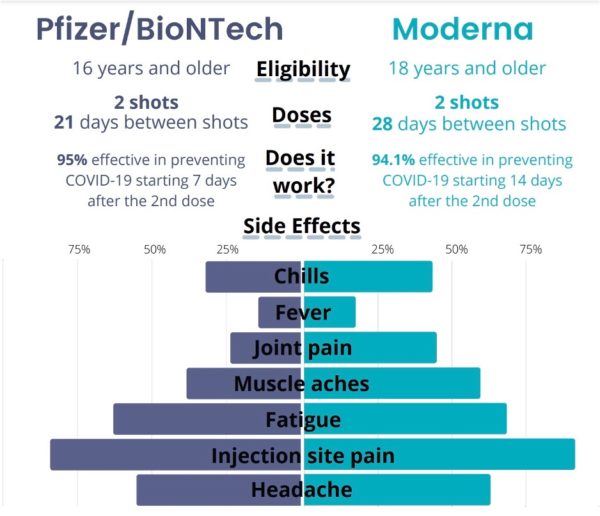 Health Matters is a biweekly opinion column. The views expressed are solely the author’s.
Health Matters is a biweekly opinion column. The views expressed are solely the author’s.
Fevers. Chills. Headache. Sore arm.
All of these hit at 1 a.m. after my second Pfizer COVID-19 vaccine shot. However, it was the happiest fever, chills and headache I’d ever had, because I knew this short-lived post-vaccination ailment would protect me from severe COVID-19 illness.
Despite knowing about the side effects, I was surprised at how much they affected me and how prevalent it was with my coworkers. With several weeks of vaccinations under way, it is important to ensure everybody getting the vaccine is patently aware of the side effects in order to plan the next day accordingly and assuage the fear of the vaccine doing more harm than good.
The chart below summarizes the two vaccines currently administered in Arlington. Both Pfizer and Moderna are considered “reactogenic” in that they stimulate a strong immune response with unpleasant but temporary side effects. Moderna, despite being less efficacious (94.1% vs. 95% for Pfizer), has 3x more vaccine than Pfizer (100 micrograms vs 30 micrograms for Pfizer), which may contribute to more side effects observed.
Reactogenicity awareness is particularly important because more Arlingtonians want the vaccine than anywhere in the U.S., and as of 2/18/21, about 27,895 doses have been administered and 8,371 fully vaccinated according to the Virginia Department of Health Vaccine Dashboard.
So why does your body react this way to the vaccine?
The immediate response is from the introduction of the vaccine materials into your arm. This immediate response is courtesy of the first branch of the immune system called innate immunity, which fights anything it doesn’t recognize. As your cells take up the mRNA that encodes a version of the coronavirus’s spike protein, the innate immune system sets off alarms to recruit more immune cells to your arm, causing inflammation and soreness, which then results in more immune cell recruitment causing the bigger picture symptoms of fever and fatigue.
During this cascade of recruitment, the second, more specific branch of the immune system is activated, called adaptive immunity. The main players in adaptive immunity are B cells, which are targeted, selective assassins that create antibodies that bind to the spike protein, and T cells, which creates a cellular “wanted” poster of the infecting pathogen so that the B cells know when and where to attack.
Adaptive immunity is the fine-tuned part of the immune system that protects against COVID-19 after the second shot. When the second shot reintroduces the pathogen to the body, the adaptive immune system sends off a cytokine flurry, overlapping the reengaged innate immune response, resulting in the fever, aches and chills.
These side effects are a natural part of vaccination and ultimately demonstrate a functioning immune system–it does not mean you have COVID-19. If you don’t have these side effects, there is no need for alarm since many are vaccinated successfully with no side effects.
Of note, the flu-like side effects are different than anaphylaxis or allergic reaction, which is a much faster immune response that is seen in minutes. This known potential reaction has prompted the CDC to recommend 15 minutes of observation time after vaccination for most people and 30 minutes for those with a history of anaphylaxis.
Scientists believe the reactogenicity of the vaccines derives from the lipid nanoparticles used to package and protect the mRNA as it enters cells. Lipid nanoparticles and mRNA are novel approaches to vaccines, and Pfizer and Moderna are the first to utilize this nanotechnology. In fact, this technology may be used to further improve efficacy for influenza vaccines, which is both underutilized (less than half of the U.S. got it last year) and underperforming compared to the COVID vaccine (flu vaccine reduces risk of going to the doctor with flu by 39% in 2019-2020). As the lipid and mRNA technology advances, the hope is that reactogenicity decreases.
What happens if you get these symptoms post-vaccination?
The first step is to rest and drink plenty of fluids. If your arm is sore, try applying a cool, wet washcloth over the area. The CDC has recommended ibuprofen, aspirin, antihistamines and acetaminophen for general pain and discomfort, but only after the shot. It is unknown whether pre-medicating before the vaccine affects how well the vaccine works.
Ultimately, while the side effects were surprisingly robust and prevalent in my healthcare circle, they went away within 48 hours. I would not let these side effects deter anybody that is medically cleared from getting the vaccine. My goal is to make sure people are prepared for the side effects and to not panic if they arise.
Dr. George C. Hwang, known to his patients as Dr. Chaucer, is a practicing anesthesiologist who also helps to run Mind Peace Clinics in Arlington. He has written for multiple journals, textbooks and medical news outlets, and has been living in Arlington for the past 15 years.


